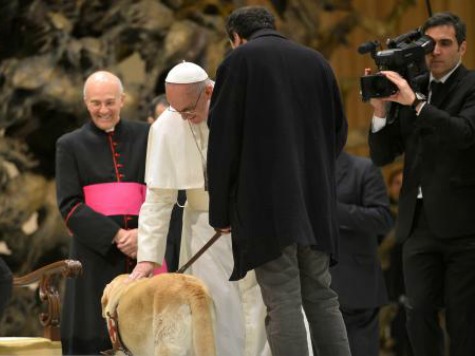The new motto for the New York Times could well be “All the news that’s fit to fabricate,” for as much fact-checking as the paper is doing when it comes to the Catholic Church. Its Thursday issue featured a front-page story titled “Dogs in Heaven? Pope Francis Leaves Pearly Gates Open,” based on a made-up meeting between Francis and a little boy whose dog had supposedly died.
According to the Times, the Pope comforted the distressed boy by saying, “One day, we will see our animals again in the eternity of Christ. Paradise is open to all of God’s creatures.”
This meeting never happened and Francis never said any such thing. Nonetheless, the Times took advantage of the tale to castigate conservatives, saying that news accounts of Francis’ remarks were seen “as a repudiation of conservative Roman Catholic theology that says animals cannot go to heaven because they have no souls.”
The Times removed the story of the meeting from its online version of the piece, and published a 166-word correction, but left the rest of the essay substantially intact.
Without the key encounter between the Pope and the boy, the story now makes the absurd claim that the Pope’s generic statement–“Holy Scripture teaches us that the fulfillment of this wonderful design also affects everything around us”–appears to “suggest that animals could go to heaven.”
Though Catholic teaching has no problem with the theory that animals could be present in the afterlife, Francis has made no such assertion.
The bigger problem here is the Times’ willingness to believe–and publish–anything that fits the narrative it wishes to propagate, without the professional courtesy of verifying its factual content.
The Puppies in Paradise piece, in fact, contains two more factual errors besides the Pope’s fictional meeting with the bereft boy and his equally fictional comment, errors that the Times has left in the story.
First, it declares that Pope Pius IX defined the doctrine of papal infallibility in 1854, when, in point of fact, that doctrine was declared by the First Vatican Council 16 years later, in 1870.
Second, the story states that Pope John Paul II “proclaimed that animals do have souls and are ‘as near to God as men are.’ But the Vatican did not widely publicize his assertion, perhaps because it so directly contradicted Pius.”
This, too, is blatantly false. John Paul’s actual words, which can be found here, do not say that animals have souls but that they have “a breath of life that they have received from God.” The phrase that they are “as near to God as men are” is simply made up.
The New York Times is so eager to pit Francis against his predecessors that they are willing to use fabricated quotes to make their point.
When it permits such sloppiness from its journalists, one wonders how long the New York Times can keep up its own fiction of being a “newspaper of record.”
Follow Thomas D. Williams on Twitter @tdwilliamsrome

COMMENTS
Please let us know if you're having issues with commenting.